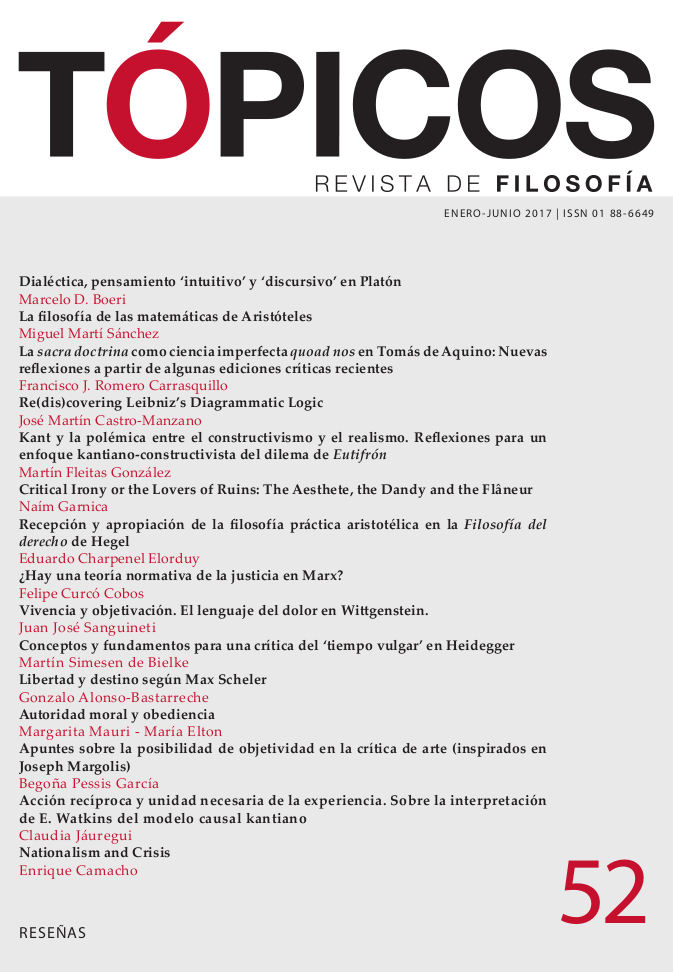Apuntes sobre la posibilidad de objetividad en la crítica de arte (inspirados en Joseph Margolis)
Publiée 2016-12-27
Mots-clés
- objetividad,
- crítica de arte,
- intersubjetividad histórica,
- Joseph Margolis,
- objetos intencionales
Comment citer
Résumé
Especialmente ante la consideración de las obras de arte como objetos Intencionales, radicalmente distintos de los objetos meramente físicos, surge la pregunta acerca de la posibilidad de objetividad en los juicios críticos sobre arte. Con esta interrogante como hilo conductor, en el siguiente trabajo se intentará sostener que, sobre todo en el marco de la tradición analítica de este problema, la propuesta de Margolis parece ser la apuesta más sólida, ya que logra responder a los desafíos que sugiere el peculiar carácter de las obras de arte. Además, propondré que el concepto de intersubjetividad histórica permite hacerse cargo adecuadamente de los retos y dificultades que suponen las obras de arte y enunciaré las ventajas de este término en relación con el de “objetividad”.
Références
- Carroll, N. (2009). On Criticism. New York, Oxon: Routledge.
- Davies, S. (1995). Relativism in Interpretation. En The Journal of Aesthetics and Art Criticism, Vol. 53, Núm. 1, 8-13.
- Garcia Leal, J. (2001). Pluralidad de interpretaciones en el arte. En Thémata. Núm. 27, 31-38.
- Ibarlucía, R. (2016). Descripción y evaluación. Algunas observaciones sobre el discurso de la crítica. En Pérez, D. e Ibarlucía, R. (comps.). Hechos y valores en filosofía teórica, filosofía práctica y filosofía del arte. (213-224). Buenos Aires: Centro de Investigaciones Filosóficas y Sociedad Argentina de Análisis Filosófico. [En prensa]
- Kant, I. (2015). Kritik der Urteilskraft. Wilhelm Weischedel (ed). Band X. Frankfurt am Main: Suhrkamp Verlag (stw).
- Margolis, J. (2009). The arts and the definition of the human: toward a philosophical anthropology. Stanford: Stanford University Press.
- ________ (2001). Selves and other texts: the case for cultural realism. University Park, PA: The Pennsylvania State University Press.
- ________ (2000). The Deviant Ontology of Artworks. En Carrol, Noël (ed). Theories of Art Today. (109-129). Wisconsin: The University of Winconsin Press.
- ________ (1999). What, after all, is a work of art? University Park, PA: The Pennsylvania State University Press.
- ________(1998). Objectivity as a Problem: An A empt at an Overview. En The Annals of the American Academy of Political and Social Science. Vol. 560, 55-68.
- ________ (1995a). Historied Thought, Constructed World: A Conceptual Primer for the Turn of the Millennium. Berkeley: University of California Press.
- ________(1995b). Interpretation Radical but Not Unruly: The New Puzzle of the Arts and History. Berkeley: University of California Press.
- ________ (1995c). Plain talk about interpretation on a relativistic model. En Journal of Aesthetics and Art Criticism. Vol. 53, Núm. 1, 1-7.
- Schaeffer, J. (2013). Pequeña ecología de los estudios literarios. Fólica, L. (trad.) Buenos Aires: Fondo de cultura económica.
- Stecker, R. (1996). Artworks: Meaning, Definition, Value. University Park, PA: The Pennsylvania State University Press.
- ________ (1992). Incompatible Interpretations. En The Journal of Aesthetics and Art Criticism. Vol. 50, Núm. 4, 291-298.






